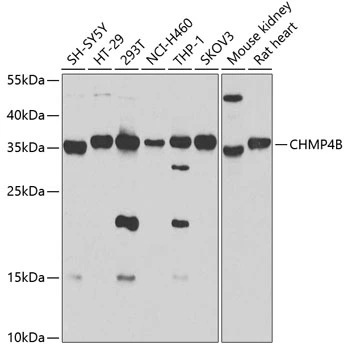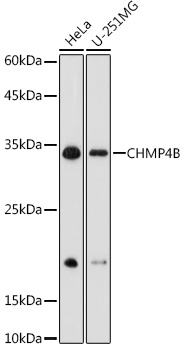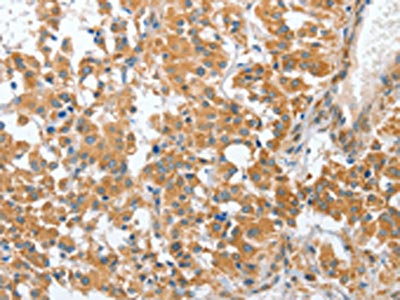
WB analysis of various sample lysates using GTX64853 CHMP4B antibody. The signal was developed with ECL plus-Enhanced. Dilution : 1:1000 Loading : 25microg per lane
CHMP4B antibody
GTX64853
ApplicationsWestern Blot
Product group Antibodies
TargetCHMP4B
Overview
- SupplierGeneTex
- Product NameCHMP4B antibody
- Delivery Days Customer9
- Application Supplier NoteWB: 1:500 - 1:2000. *Optimal dilutions/concentrations should be determined by the researcher.Not tested in other applications.
- ApplicationsWestern Blot
- CertificationResearch Use Only
- ClonalityPolyclonal
- ConjugateUnconjugated
- Gene ID128866
- Target nameCHMP4B
- Target descriptioncharged multivesicular body protein 4B
- Target synonymsC20orf178, CHMP4A, CTPP3, CTRCT31, SNF7, SNF7-2, Shax1, VPS32B, Vps32-2, dJ553F4.4, charged multivesicular body protein 4b, SNF7 homolog associated with Alix 1, Snf7 homologue associated with Alix 1, chromatin modifying protein 4B, chromatin-modifying protein 4b, vacuolar protein-sorting-associated protein 32-2
- HostRabbit
- IsotypeIgG
- Protein IDQ9H444
- Protein NameCharged multivesicular body protein 4b
- Scientific DescriptionThis gene encodes a member of the chromatin-modifying protein/charged multivesicular body protein (CHMP) protein family. The protein is part of the endosomal sorting complex required for transport (ESCRT) complex III (ESCRT-III), which functions in the sorting of endocytosed cell-surface receptors into multivesicular endosomes. The ESCRT machinery also functions in the final abscisson stage of cytokinesis and in the budding of enveloped viruses such as HIV-1. The three proteins of the CHMP4 subfamily interact with programmed cell death 6 interacting protein (PDCD6IP, also known as ALIX), which also functions in the ESCRT pathway. The CHMP4 proteins assemble into membrane-attached 5-nm filaments that form circular scaffolds and promote or stabilize outward budding. These polymers are proposed to help generate the luminal vesicles of multivesicular bodies. Mutations in this gene result in autosomal dominant posterior polar cataracts.[provided by RefSeq, Oct 2009]
- Storage Instruction-20°C or -80°C,2°C to 8°C
- UNSPSC12352203




